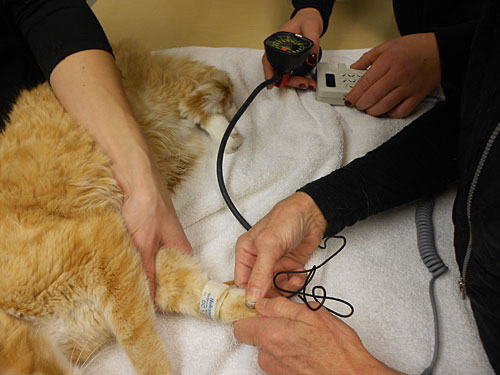One of our clients came in with her cat after she observed him breathing faster than normal. This particular patient is currently being treated for renal failure, but had not shown any increased respiratory rates yet. Cats in renal failure often have high blood pressure, which if left too high for too long, can lead to lethargy and sudden blindness. In order to get a better picture of the cat’s current condition Doctor Neumeister decided to measure his blood pressure.
The systolic blood pressure of this patient ranged at 208/210/210. This is defined as Stage III or severe hypertension. Treatment is needed in order to limit organ damage.

The Doppler technique is the preferred method of blood pressure measurement in cats.

In this particular case Doctor Neumeister used the Doppler Technique to determine the systolic blood pressure ranges of the patient. A pneumatic cuff is wrapped snuggly around the cat’s forearm above the wrist (carpus).

Some gel is applied to the Doppler probe before it is placed over the median artery on the ventral and carpal pads.

The cuff is inflated approx. 30 to 40 mm Hg higher than the expected systolic pressure, then the cuff is deflated at approximately 3-4 mm Hg/sec.

The Doppler flow meter detects the blood flow as a change in the frequency of reflected sound (Doppler shift) due to the motion of underlying red blood cells. When the audible blood flow signal is heard it denotes the systolic blood pressure (pressure in the arteries when the heart beats). We repeat the measurement several times for accuracy reasons.
